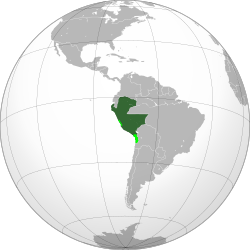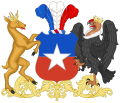Peruvian Republic República Peruana (Spanish) | |||||||||
|---|---|---|---|---|---|---|---|---|---|
| 1879–1883 | |||||||||
 Peru in 1881
| |||||||||
| Capital | Lima[a] (1881–1883) Cajamarca[b] (1881–1884) | ||||||||
| Government | Military occupation by Chile | ||||||||
| President (of Chile) | |||||||||
• 1879–1881 | Aníbal Pinto | ||||||||
• 1881–1883 | Domingo Santa María | ||||||||
| President (of Peru) | |||||||||
• 1881 | Francisco García Calderón | ||||||||
• 1881–1883 | Lizardo Montero | ||||||||
• 1883–1885 | Miguel Iglesias | ||||||||
| Commander in Chief of the Occupation Forces | |||||||||
• 1881 | Cornelio Saavedra | ||||||||
• 1881 | Pedro Lagos | ||||||||
• 1881–1883 | Patricio Lynch | ||||||||
| History | |||||||||
| 2 November 1879 | |||||||||
| 23 October 1883 | |||||||||
• Chilean withdrawal | 29 October 1883 | ||||||||
| |||||||||
| Today part of | Chile Peru | ||||||||
The Chilean occupation of Peru (Spanish: Ocupación chilena del Perú) began on November 2, 1879, with the beginning of the Tarapacá campaign during the War of the Pacific. The Chilean Army successfully defeated the Peruvian Army and occupied the southern Peruvian territories of Tarapacá, Arica and Tacna. By January 1881, the Chilean army had reached Lima, and on January 17 of the same year, the occupation of Lima began.
During the occupation, a collaborationist government was established in La Magdalena, known as the Government of La Magdalena (Spanish: Gobierno de La Magdalena), headed by Francisco García Calderón, that served as the representative government of Peru in order to negotiate the end of the war. After García Calderón's refusal to agree to the territorial transfer of Tarapacá, Arica, and Tacna, he was exiled to Chile along with his wife, where he was pressured again until Lizardo Montero's Cry of Montán, and the establishment of his new government in Cajamarca, known as the Regenerator Government (Spanish: Gobierno Regenerador), which would be recognized as the successor of García Calderón's government by Chile.
The occupation came to an end after the signing of the Treaty of Ancón on October 23, 1883, with Chilean troops retreating on October 29. However, Chilean forces continued to occupy and administer Tarata until 1925, while a final agreement between the two countries regarding Tacna and Arica was reached in 1929.
Cite error: There are <ref group=lower-alpha> tags or {{efn}} templates on this page, but the references will not show without a {{reflist|group=lower-alpha}} template or {{notelist}} template (see the help page).



